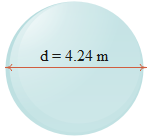
The diameter of a sphere is 4.24 m. Its surface area with due regard to significant figures is:
\[\begin{align}
& A.\,5.65\,{{m}^{2}} \\
& B.\,56.5\,{{m}^{2}} \\
& C.\,565\,{{m}^{2}} \\
& D.\,5650\,{{m}^{2}} \\
\end{align}\]
Answer
522.6k+ views
Hint: The radius of the sphere equals half the value of the diameter of the sphere. The surface area of the sphere is equal to 4(pi) times the square of the radius. The significant figures in the value of the diameter is 2, thus, the total number of significant figures in the value of the area should also be 2.
Formula used:
\[S=4\pi {{r}^{2}}\]
Complete answer:
From the given information, we have the data as follows.
The diameter of a sphere is 4.24 m.

Firstly, we have to find the value of the radius using the given value of the diameter of the sphere. So, we have the formula that converts the diameter into the radius, that is,
\[\begin{align}
& r=\dfrac{d}{2} \\
& \Rightarrow r=\dfrac{4.24}{2} \\
& \therefore r=2.12\,m \\
\end{align}\]
Therefore, the radius of the sphere is 2.12 m.
Here keep a note that the number of digits present after the decimal point is 2.
Now, we are supposed to find the value of the surface area of the sphere. The surface area of the sphere is given by the formula as follows.
\[S=4\pi {{r}^{2}}\]
Where S is the surface area of the sphere and r is the radius of the sphere.
Substitute the obtained value of the radius of the sphere in the above equation. So, we have,
\[\begin{align}
& S=4\pi \times {{2.12}^{2}} \\
& \Rightarrow S=4\times \dfrac{22}{7}\times 2.12\times 2.12 \\
& \therefore S=56.50\,{{m}^{2}} \\
\end{align}\]
Thus, the surface area of the sphere is \[56.50\,{{m}^{2}}\].
\[\therefore \] The surface area of the sphere with the diameter 4.24 m is\[56.50\,{{m}^{2}}\]
Thus, option (B) is correct.
Note:
Even we can solve this problem using the diameter of the sphere. Instead of radius, we have to replace it with the diameter of the sphere. When we replace the radius with the diameter, we get the formula as the product of (pi) and the square of the diameter.
Formula used:
\[S=4\pi {{r}^{2}}\]
Complete answer:
From the given information, we have the data as follows.
The diameter of a sphere is 4.24 m.

Firstly, we have to find the value of the radius using the given value of the diameter of the sphere. So, we have the formula that converts the diameter into the radius, that is,
\[\begin{align}
& r=\dfrac{d}{2} \\
& \Rightarrow r=\dfrac{4.24}{2} \\
& \therefore r=2.12\,m \\
\end{align}\]
Therefore, the radius of the sphere is 2.12 m.
Here keep a note that the number of digits present after the decimal point is 2.
Now, we are supposed to find the value of the surface area of the sphere. The surface area of the sphere is given by the formula as follows.
\[S=4\pi {{r}^{2}}\]
Where S is the surface area of the sphere and r is the radius of the sphere.
Substitute the obtained value of the radius of the sphere in the above equation. So, we have,
\[\begin{align}
& S=4\pi \times {{2.12}^{2}} \\
& \Rightarrow S=4\times \dfrac{22}{7}\times 2.12\times 2.12 \\
& \therefore S=56.50\,{{m}^{2}} \\
\end{align}\]
Thus, the surface area of the sphere is \[56.50\,{{m}^{2}}\].
\[\therefore \] The surface area of the sphere with the diameter 4.24 m is\[56.50\,{{m}^{2}}\]
Thus, option (B) is correct.
Note:
Even we can solve this problem using the diameter of the sphere. Instead of radius, we have to replace it with the diameter of the sphere. When we replace the radius with the diameter, we get the formula as the product of (pi) and the square of the diameter.
Recently Updated Pages
Why are manures considered better than fertilizers class 11 biology CBSE

Find the coordinates of the midpoint of the line segment class 11 maths CBSE

Distinguish between static friction limiting friction class 11 physics CBSE

The Chairman of the constituent Assembly was A Jawaharlal class 11 social science CBSE

The first National Commission on Labour NCL submitted class 11 social science CBSE

Number of all subshell of n + l 7 is A 4 B 5 C 6 D class 11 chemistry CBSE

Trending doubts
Differentiate between an exothermic and an endothermic class 11 chemistry CBSE

10 examples of friction in our daily life

One Metric ton is equal to kg A 10000 B 1000 C 100 class 11 physics CBSE

Difference Between Prokaryotic Cells and Eukaryotic Cells

1 Quintal is equal to a 110 kg b 10 kg c 100kg d 1000 class 11 physics CBSE

State the laws of reflection of light




